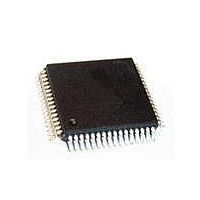SAK-XC164CM-16F20F BA Infineon Technologies, SAK-XC164CM-16F20F BA Datasheet - Page 62

SAK-XC164CM-16F20F BA
Manufacturer Part Number
SAK-XC164CM-16F20F BA
Description
IC MCU 16BIT FLASH 64-LQFP
Manufacturer
Infineon Technologies
Series
XC16xr
Datasheet
1.SAF-XC164CM-4F20F_AA.pdf
(70 pages)
Specifications of SAK-XC164CM-16F20F BA
Program Memory Type
FLASH
Program Memory Size
128KB (128K x 8)
Package / Case
64-LFQFP
Core Processor
C166SV2
Core Size
16-Bit
Speed
20MHz
Connectivity
CAN, SPI, UART/USART
Peripherals
PWM, WDT
Number Of I /o
47
Ram Size
8K x 8
Voltage - Supply (vcc/vdd)
2.35 V ~ 2.7 V
Data Converters
A/D 14x8/10b
Oscillator Type
Internal
Operating Temperature
-40°C ~ 125°C
Processor Series
XC164x
Core
C166S V2
Data Bus Width
16 bit
Data Ram Size
8 KB
Interface Type
ASC/CAN/SSC
Maximum Clock Frequency
20 MHz
Number Of Programmable I/os
47
Number Of Timers
5
Operating Supply Voltage
5 V
Maximum Operating Temperature
+ 125 C
Mounting Style
SMD/SMT
3rd Party Development Tools
PK166, CA166, AR166, ULINK2
Minimum Operating Temperature
- 40 C
On-chip Adc
14-ch x 10-bit
Packages
PG-LQFP-64
Max Clock Frequency
20.0 MHz
Sram (incl. Cache)
8.0 KByte
Can Nodes
2
A / D Input Lines (incl. Fadc)
14
Program Memory
128.0 KByte
Lead Free Status / RoHS Status
Lead free / RoHS Compliant
For Use With
B158-H8961-X-X-7600IN - KIT EASY XC164CMXC164CMUCANIN - KIT U-CAN STARTER XC164CM
Eeprom Size
-
Lead Free Status / Rohs Status
Lead free / RoHS Compliant
Other names
SP000245661
The used mechanism to generate the master clock is selected by register PLLCON.
CPU and EBC are clocked with the CPU clock signal
same frequency as the master clock (
two:
The specification of the external timing (AC Characteristics) depends on the period of the
CPU clock, called “TCP”.
The other peripherals are supplied with the system clock signal
frequency as the CPU clock signal
Bypass Operation
When bypass operation is configured (PLLCTRL = 0x
the internal oscillator (input clock signal XTAL1) through the input- and output-
prescalers:
f
If both divider factors are selected as ‘1’ (PLLIDIV = PLLODIV = ‘0’) the frequency of
directly follows the frequency of
cycle of the input clock
The lowest master clock frequency is achieved by selecting the maximum values for both
divider factors:
f
Phase Locked Loop (PLL)
When PLL operation is configured (PLLCTRL = 11
enabled and provides the master clock. The PLL multiplies the input frequency by the
factor F (
the output divider (F = PLLMUL+1 / (PLLIDIV+1 × PLLODIV+1)). The PLL circuit
synchronizes the master clock to the input clock. This synchronization is done smoothly,
i.e. the master clock frequency does not change abruptly.
Due to this adaptation to the input clock the frequency of
is locked to
of individual TCMs.
The timing listed in the AC Characteristics refers to TCPs. Because
f
circumstances.
The actual minimum value for TCP depends on the jitter of the PLL. As the PLL is
constantly adjusting its output frequency so it corresponds to the applied input frequency
(crystal or oscillator) the relative deviation for periods of more than one TCP is lower than
for one single TCP (see formula and
Data Sheet
MC
MC
MC
, the timing must be calculated using the minimum TCP possible under the respective
=
=
f
CPU
f
f
OSC
OSC
f
=
MC
/ ((PLLIDIV + 1) × (PLLODIV + 1)).
/ ((3 + 1) × (14 + 1)) =
f
f
MC
OSC
=
f
/ 2. This factor is selected by bit CPSYS in register SYSCON1.
OSC
. The slight variation causes a jitter of
× F) which results from the input divider, the multiplication factor, and
f
OSC
.
f
OSC
f
OSC
f
CPU
so the high and low time of
Figure
/ 60.
f
CPU
.
60
=
16).
f
MC
) or can be the master clock divided by
B
) the on-chip phase locked loop is
B
f
f
MC
CPU
) the master clock is derived from
which also affects the duration
f
. The CPU clock can have the
MC
is constantly adjusted so it
f
f
MC
SYS
Electrical Parameters
is defined by the duty
which has the same
f
CPU
is derived from
Derivatives
V1.4, 2007-03
XC164CM
f
MC
















